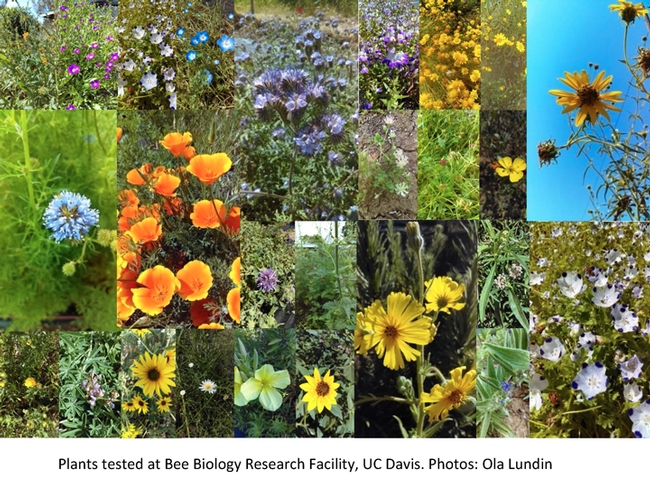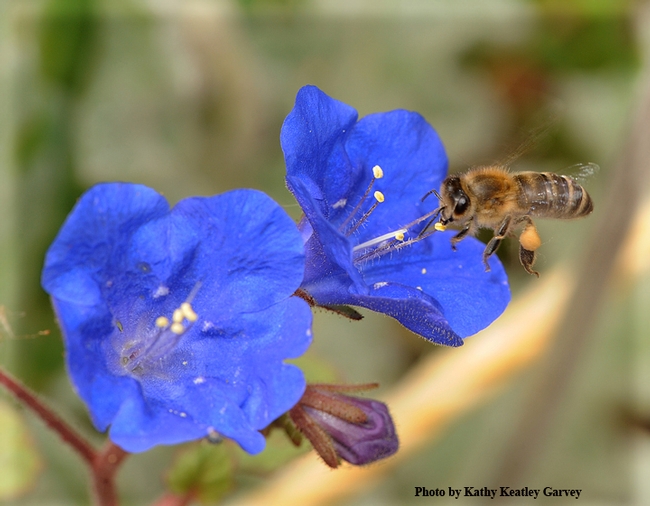- Author: Kathy Keatley Garvey

Miridae is working with pollination ecologist Neal Williams, professor, and urban landscape entomologist Emily Meineke, assistant professor. Also on the team is assistant professor Haven Kiers of the Department of Human Ecology, who specializes in landscape architecture and environmental design.
"This year we are collaborating with UC Davis entomologists who will use these seed piles to learn about how certain urban conditions impact native bee species," Krimmel said.
Those who live in the Sacramento area (including Davis) and the East Bay, are invited to participate. Krimmel explains:
- You sign up here
- You get 3 free packets of native wildflower seeds
- You drop them somewhere in your neighborhood or commute
- You DO NOT water or maintain them
- You monitor them once a month until May using the Miridae app and "tell us what you see"
"We encourage folks of all ages to participate, and we provide resources such as seedling identification guides to help you identify the species in your seed piles," Krimmel said. "This is a great project for school classes and scout troops in addition to individuals."
It works like this: "Community participants to drop small piles of local, California native seeds in urban areas where they live or work, then monitor the results through repeated observations," Krimmel said. "Using data from participants on the conditions under which certain species of these locally adapted seeds spread, survive, or die, we can gain a better understanding of which native species to incorporate into the built environment and where to put them for the greatest ecological benefit and resilience."
"The basic goal is to learn which species can thrive in human-occupied spaces, especially transportation corridors," said Krimmel, who studied native plant-insect interactions at UC Davis with major professor Jay Rosenheim, distinguished professor of entomology. He received his doctorate in ecology in January, 2015.
A kickoff gathering is set from 4 to 7 p.m., Thursday, Nov. 17 at the Jackrabbit Brewing in West Sacramento where participants can pick up their seed packets, meet other participants, and perhaps buy a native plant and/or beverage. "There will be other pickup options as well," he said.
Krimmel founded the company, located at 1385 Terminal St., West Sacramento, with the intention of “creating habitat for native species within human-occupied areas and engaging people with the species interactions occurring in these habitations.” Its mission: "To strengthen connections between people, native plants, and wildlife through design, construction, outreach and research."
The name, Miridae, is Latin for a family of insects known as “plant bugs,” or mirids, which Krimmel researches. One of the most well-known mirid is the lygus bug, a serious pest of cotton, strawberries and alfalfa.
Miridae won the highly competitive 2020 Award of Excellence for Communication from the American Society of Landscape Architects (ASLA) for its Seed Bank Living Wall at DPR Construction, Sacramento. The ASLA awards, judged by a jury of professionals, honor the best in landscape architecture from around the globe.
Of his company, Krimmel says: “We create habitat for, and engage people with, native plants and the wildlife they support. We do this by tying together design, science, and high-quality construction to create landscapes that are beautiful, resilient, and ecologically powerful.” His goal, with each project, is to “come one step closer to creating a network of habitat gardens and migration corridors to support resilient populations of native species.”
Krimmel may be reached via his website www.miridae.com or on Instagram.
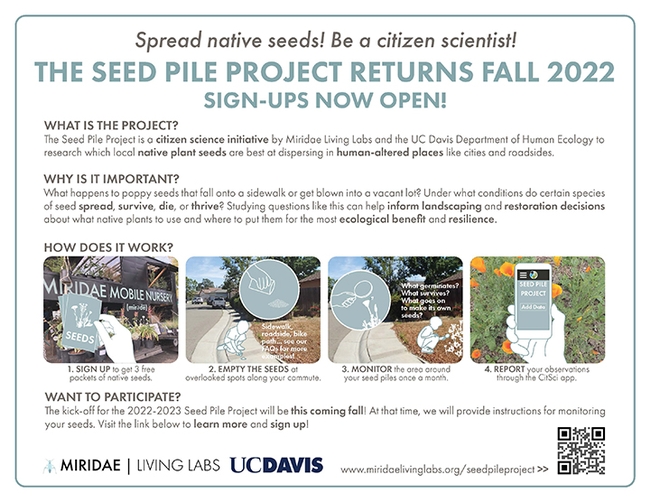
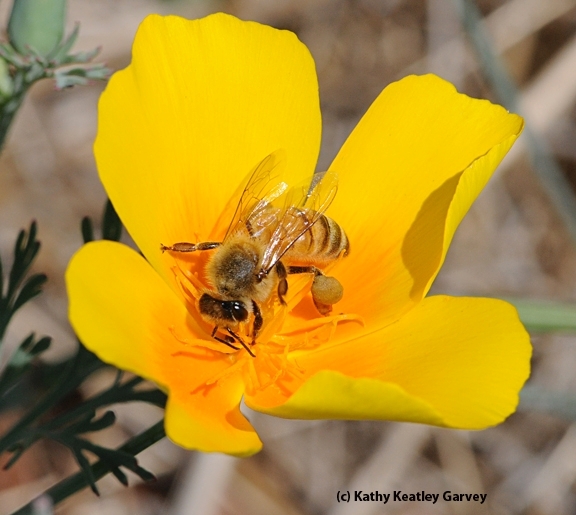
- Author: Kathy Keatley Garvey
Miridae, a company founded and owned by UC Davis-trained ecologist Billy Krimmel, won the highly competitive 2020 Award of Excellence for Communication from the American Society of Landscape Architects (ASLA) for its Seed Bank Living Wall at DPR Construction, Sacramento.
The ASLA awards, judged by a jury of professionals, honor the best in landscape architecture from around the globe. ASLA celebrated the winners at its conference, held Oct. 2-5 in Miami Beach, Fla.
A number of nationally known landscape architecture firms competed for the award “which is some nice icing on the cake!” commented Krimmel, who founded the company in 2015, a year after receiving his doctorate in ecology from UC Davis.
Miridae, led by UC Davis and Stanford graduates, is a diverse and interdisciplinary team of ecologists, landscape architects and builders.
California Native Species
The seed bank, using California native species, challenges the concept of a typical ‘living wall' by highlighting dormant seeds as living plants instead of the leaves and stems normally associated with living plants, Krimmel said.
With a collaborative team of artists and fabricators, Krimmel and his team challenged the look and feel of the traditional “green” living wall and instead proposed a living wall of dormant plant seeds.
Krimmel describes the project as “a celebration of place,” specifically Sacramento's Central Valley. The project is located at DPR's midtown Sacramento location at 1801 J St.
“The dormant seeds in the wall, physically held within the roots of each highlighted plant species, may extend beyond the life of the building,” Miridae writes on its website. “It is a reserve for the future and a concept that challenges how we think about what an individual plant is and how we cohabitate with nature.”
The concept “arms our client, DPR Construction, with a new mission to support native habitat!” Krimmel said. DPR, founded in 1990, is a national technical builder that specializes in highly complex and sustainable projects. Its Sacramento headquarters are at the corner of 18th and J streets. DPR is named for its founders, Doug Woods, Peter Nosler and Ron Davidowski (the D, P and R).
Featured in Magazine and Website
Landscape Architecture Magazine spotlighted the Miridae project in a full-page spread in the print copy, and it is also featured on ASLA's website.
From the ASLA website: “Our project began with a call for a ‘living wall' from a prominent national construction company moving their regional headquarters to Downtown Sacramento. They wanted a living wall that was sustainable, provided a sense of location, and required little maintenance. We wanted to create something that motivated the company to use habitat-crucial native plants in their construction projects and that would highlight the beauty and the benefits of these often-overlooked species. Thus, we decided to pursue a different concept for this living wall, one we have titled, the Seed Bank. Challenging the design standard that highlights the leaves, stems, and flowers we typically associate with plants, the Seed Bank uses dormant, live seeds of important California native species to highlight the unseen elements of these plants and to organize them in a spatially-explicit way that ties the local species to their natural and potential distributions.”
The native plants used in the Seed Wall:
- Arroyo Lupine
- Purple Needlegrass
- California Poppy
- Narrow Leaf Milkweed
- Deergrass
- Common Yarrow
- Vinegarweed
- Hairy Evening Primrose
- Common Fiddleneck
- Bolander's Sunflower
- Turkey Mullein
- Common Madia
- Creeping Wild Rye
- Tomcat Clover
- Blue Wild Rye
Creating Habitat for Native Species
Krimmel founded the company with the intention of “creating habitat for native species within human-occupied areas and engaging people with the species interactions occurring in these habitations.”
The name, Miridae, is Latin for a family of insects known as “plant bugs,” or mirids, which Krimmel researches. One of the most well-known mirid is the lygus bug, a serious pest of cotton, strawberries and alfalfa.
Of his company, Krimmel says: “We create habitat for, and engage people with, native plants and the wildlife they support. We do this by tying together design, science, and high-quality construction to create landscapes that are beautiful, resilient, and ecologically powerful.”
His goal, with each project, is to “come one step closer to creating a network of habitat gardens and migration corridors to support resilient populations of native species.”
At UC Davis, Krimmel studied with Jay Rosenheim, distinguished professor, Department of Entomology and Nematology. Focusing his research on native plant-insect interactions, he wrote his dissertation on “Plant Traits and Plant-Herbivore-Omnivore Interactions.” He holds a bachelor of science degree in human biology (2008), with honors, from Brown University, Providence, RI.
Krimmel continues to be active in the research community, writing peer-reviewed journal articles on native plants and insects, and a quarterly column in the peer-reviewed journal Grasslands. “My vision is to connect landscaping with science and restoration,” he said.
With Miridae, he has overseen the design and building of more than 150 landscape projects throughout the Sacramento and Bay Area regions. He has severed as a board member and chair of outreach and development for the California Native Grasslands Association since 2015.
The UC Davis alumnus regularly presents at the Wildflowers and Conservation Biology to American River College, and the Waterwise Gardening Workshop series by the Yolo Research Conservation District. He also presents at a UC Davis course, Natural RX, discussing nature's healing abilities; and at the Hedgerow Farms Field Day on insect interactions in native gardens.

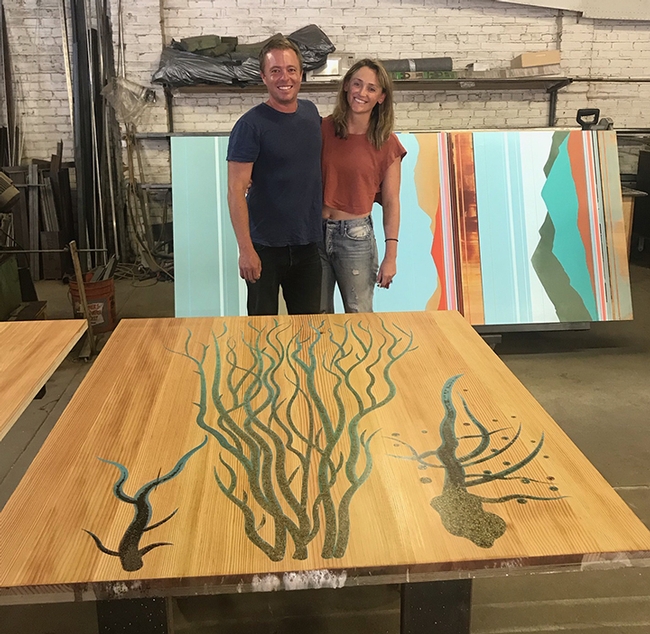

- Author: Kathy Keatley Garvey
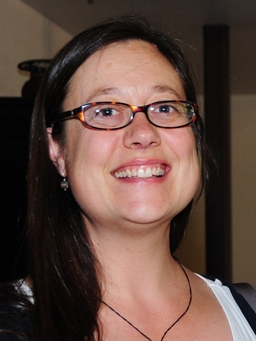


The two-year research, led by Ola Lundin, a former postdoctoral fellow in the Neal Williams lab, UC Davis Department of Entomology and Nematology and published in the Journal of Applied Ecology, details what plants proved most attractive to honey bees, wild bees and other pollinators, as well as what drew such natural enemies as predators and parasitic wasps.
The research, “Identifying Native Plants for Coordinated Habitat Management of Arthropod Pollinators, Herbivores and Natural Enemies,” is co-authored by Williams, professor of entomology and a Chancellor's Fellow at UC Davis; and project specialist Kimiora Ward of the Williams lab.
“I hope this study can inform selection of plants that support pollinators and natural enemies without enhancing potential pests,” said Lundin, first-author of the paper and now a postdoctoral fellow in the Department of Ecology, Swedish University of Agricultural Sciences, Uppsala.
“Planting wildflowers is a key strategy promoted nationally to support wild and managed bees,” said Williams. “Successful adoption of these plantings in agricultural landscapes will require that they not only support pollinators but that they also avoid supporting too many pests. Plant selection going forward will need to balance multiple goals of pollinators pest management and other functions. This research is a first step on the path to identifying plants that will meet these goals."
The three scientists, who conceived the ideas and developed the methodology for the research project, established 43 plant species in a garden experiment on the grounds of the Harry H. Laidlaw Jr. Honey Bee Research Facility at UC Davis. They selected plant species that were drought-tolerant; native to California (except for buckwheat, Fagopyrum esculentum, known to attract natural enemies and widely used in conservation biological control); and, as a group, covered a range of flowering periods throughout the season.
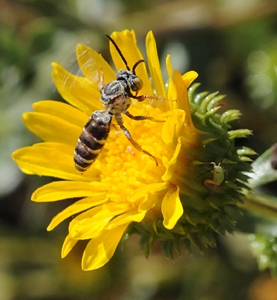
“For early season bloom, Great Valley phacelia (Phacelia ciliata) was a real winner in terms of being attractive for both wild bees and honey bees,” Lundin said. “Elegant Clarkia (Clarkia unguiculata) flowers in late spring and was the clearly most attractive plant for honey bees across the dataset. The related Fort Miller Clarkia (C. williamsonii) was also quite attractive for honey bees and had the added benefit that a lot of minute pirate bugs visited the flowers.”
Lundin said that common yarrow (Achillea millefolium) “attracted “attracted the highest numbers of parasitic wasps but also many herbivores, including Lygus bugs.”
“In general a lot of parasitic wasps were found on Asteraceae species (the daisy family) and this was a somewhat surprising result considering that they have narrow corollas, and for parasitic wasps relatively deep corollas that can restrict their direct access to nectar. Under the very dry conditions in late summer, Great Valley gumplant (Grindelia camporum) and Vinegarweed (Trichostema lanceolatum) both performed well and attracted high numbers of wild bees.”
The team found that across plant species, herbivore, predator and parasitic wasp abundances were “positively correlated,” and “honey bee abundance correlated negatively to herbivore abundance.”
The take-home message is that “if you're a gardener or other type of land manager, what you'd likely prefer would be a mix of some of the most promising plant species taking into account their individual attractiveness for these arthropod groups, plus several more factors including costs for seed when planting larger areas,” Lundin said.
“Plant choice can also depend on how you weigh the importance of each arthropod group and whether you are interested in spring, summer or season-long bloom,” Lundin added. Those are some of the questions that the Williams lab plans to explore in future projects.
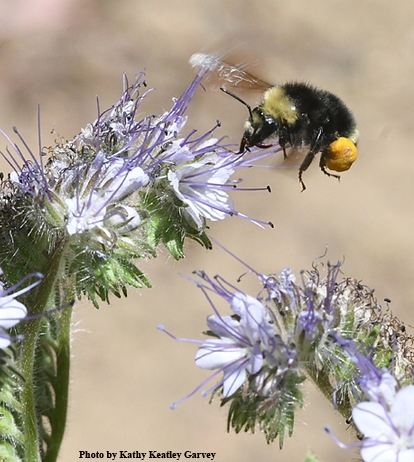
Williams praised the “uniquely capable team that came together.”
“Ola is an emerging leader in considering integrated management of pests and pollinators and Kimiora is a known expert in developing regionally-relevant plant materials to support pollinators,” Williams said. “They and some talented UC Davis undergraduates--notably Katherine Borchardt and Anna Britzman--compiled a tremendously useful study.”
The overall aim of the study “was to identify California native plants, and more generally plant traits, suitable for coordinated habitat management of arthropod pollinators, herbivores and natural enemies and promote integrated ecosystem services in agricultural landscapes,” the researchers wrote.
More specifically, they asked:
- Which native plants among our candidate set attract the highest abundances of wild bees, honeybees, herbivores, predators, and parasitic wasps,
- If the total abundances of arthropods within these functional groups across plant speacies are related to the peak flowering week, floral area, or flower type of the focal plant species, and
- If the total abundances of arthropods within these functional groups are correlated to each other across plant species.
“A first critical step for design and implementation of multifunctional plantings that promote beneficial arthropods while controlling insect pests is to identify suitable plant species to use,” the authors wrote in their abstract. “We aimed to identify California native plants and, more generally, plant traits suitable for the coordinated management of pollinators (wild bees and honey bees), insect herbivores and arthropod natural enemies (predators and parasitic wasps).”
At the time, the Laidlaw grounds included nearly 50 bee colonies: some 20 to 40 honey bee colonies, and eight managed research colonies of the yellow-faced bumble bee, Bombus vosnesenkii.
The project received funding from the USDA Resources Conservation Service, USDA Agricultural Marketing Service, USDA National Institute of Food and Agriculture and a Swedish foundation for scientific research, the Carl Tryggers Stiftelse for Vetenskaplig Forskning.
